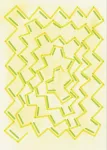(Press-News.org) RESEARCH TRIANGLE PARK, N.C. -- A new approach to studying conjugated polymers made it possible for an Army-funded research team to measure, for the first time, the individual molecules' mechanical and kinetic properties during polymerization reaction. The insights gained could lead to more flexible and robust soft electronic materials, such as health monitors and soft robotics.
Conjugated polymers are essentially clusters of molecules strung along a backbone that can conduct electrons and absorb light. This makes them a perfect fit for creating soft optoelectronics, such as wearable electronic devices; however, as flexible as they are, these polymers are difficult to study in bulk because they aggregate and fall out from solution.
"Conjugated polymers are a fascinating class of materials due to their inherent optical and electronic properties which are dictated by their polymer structure," said Dr. Dawanne Poree, program manager, U.S. Army Combat Capabilities Development Command, known as DEVCOM, Army Research Laboratory. "These materials are highly relevant to a number of applications of interest to Army and DoD including portable electronics, wearable devices, sensors, and optical communication systems. To date, unfortunately, it has been difficult to develop conjugated polymers for targeted applications due to a lack of viable tools to study and correlate their structure-property relationships."
With Army funding, researchers at Cornell University employed an approach they pioneered on other synthetic polymers, called magnetic tweezers, that allowed them to stretch and twist individual molecules of the conjugated polymer polyacetylene. The research was published in the journal Chem.
"Through the use of novel single-molecule manipulation and imaging approaches, this work provided the first observations of single-chain behaviors in conjugated polymers which lays the foundation for the rational design and processing of these materials to enable widespread application," Poree said.
Previous efforts to address the solubility of conjugated polymers have often relied upon chemical derivatization, in which the structures are modified with functional groups of atoms. However, that approach can affect the polymer's innate properties.
"The conjugated polymer is really a prototype," said Dr. Peng Chen, the Peter J.W. Debye professor of chemistry and chemical biology at Cornell. "You always modify it to tailor it for applications. We are hoping everything we measured - the fundamental properties of synthesis kinetics, the mechanical property - become benchmark numbers for people to think about other polymers of the same category."
In 2017, Chen's group was the first to use the magnetic tweezers measurement technique to study living polymerization, visualizing it at the single-molecule level. The technique had already been used in the biophysics field for studying DNA and proteins, but no one had successfully extended it to the realm of synthetic polymers.
The process works by affixing one end of a polymer strand to a glass coverslip and the other end to a tiny magnetic particle. The researchers then use a magnetic field to manipulate the conjugated polymer, stretching or twisting it, and measuring the response of a single polymer chain that grows.
The amounts are so small, they stay soluble in solution, the way bulk amounts normally would not.
The team measured how long chains of conjugated polymers, which consist of hundreds of thousands of monomer units, grow in real time. They discovered these polymers add a new monomer per second, a much faster growth than their nonconjugated analogs.
"We found that while growing in real time, this polymer forms conformational entanglements," Chen said. "All polymers we have studied form conformational entanglements, but for this conjugated polymer this conformational entanglement is looser, allowing it to grow faster."
By pulling and stretching individual conjugated polymers, so-called force extension measurements, the researchers were able to assess their rigidity and better understand how they can bend in different directions while remaining conjugated and retaining electron conductivity.
They also discovered the polymers displayed diverse mechanical behaviors from one individual chain to the next-behaviors that had been predicted by theory but never observed experimentally.
The findings highlight both the uniqueness of conjugated polymers for a range of applications as well as the strength of using a single-molecule manipulation and imaging technique on synthetic materials.
"Now we have a new way to study how these conjugated polymers are made chemically and what is the fundamental mechanical property of this type of material," Chen said. "We can study how these fundamental properties change when you start tailoring them for application purposes. Maybe you can make it more mechanically flexible and make the polymer longer, or adjust the synthesis condition to either synthesize the polymer in a faster or slower way."
INFORMATION:
Visit the laboratory's Media Center to discover more Army science and technology stories
As the Army's national research laboratory, ARL is operationalizing science to achieve transformational overmatch. Through collaboration across the command's core technical competencies, we lead in the discovery, development and delivery of the technology-based capabilities required to make Soldiers more successful at winning the nation's wars and come home safely. DEVCOM Army Research Laboratory is an element of the U.S. Army Combat Capabilities Development Command. DEVCOM is a major subordinate command of the Army Futures Command.
DALLAS (SMU) -- A team of SMU biological scientists has confirmed that P-glycoprotein (P-gp) has the ability to remove a toxin from the brain that is associated with Alzheimer's disease.
The finding could lead to new treatments for the disease that affects nearly 6 million Americans. It was that hope that motivated lead researchers James W. McCormick and Lauren Ammerman to pursue the research as SMU graduate students after they both lost a grandmother to the disease while at SMU.
In the Alzheimer's brain, abnormal levels of amyloid-β proteins clump together to form plaques that collect between neurons and can disrupt cell function. ...
Why can some people weather the stress of social isolation better than others, and what implications does this have for their health? New research from the Communication Neuroscience Lab at the Annenberg School for Communication at the University of Pennsylvania found that people who felt a strong sense of purpose in life were less lonely during the COVID-19 pandemic. Did they achieve less loneliness by flouting public health guidance? No. Although lonelier people were less likely to want to follow public health guidance, people with a stronger sense of purpose also expressed more willingness to engage in social distancing, hand washing, and other ...
A new study looking at the way human cells activate the immune system in response to SARS-CoV-2 infection could open the door to even more effective and powerful vaccines against the coronavirus and its rapidly emerging variants keeping the global pandemic smoldering.
Researchers from Boston University's National Emerging Infectious Diseases Laboratories (NEIDL) and the Broad Institute of MIT and Harvard say it's the first real look at exactly what types of "red flags" the human body uses to enlist the help of T cells--killers sent out by the immune system to destroy infected cells. Until now, COVID vaccines have been focused on activating a different type of immune cell, B cells, which are responsible for creating antibodies. Developing vaccines to activate ...
Steroid (sex) hormones play a central role in sexual development: They help determine how boys become boys and girls become girls. If these hormones are disrupted during fetal life, it can lead to a string of reproductive disorders at birth and later in life, including malformed genitals and decreased fertility.
Many environmental chemicals are known to disrupt the hormone system and are often referred to as endocrine disrupting chemicals. Azole fungicides constitute one group that can act as endocrine disruptors. Azoles are used to combat yeast infestations in seed and food crops, but are also used in medications for humans.
Most azoles used in medicines are tightly regulated and their use is well controlled. However, some are sold over-the-counter, for ...
Philadelphia, June 16, 2021 - The SARS-CoV-2 virus that causes COVID-19 may have the ability to reactivate dormant tuberculosis (TB). In a novel study scientists END ...
In a new publication from Cardiovascular Innovations and Applications; DOI https://doi.org/10.15212/CVIA.2021.0011, Xiao-lei Yin, Dong-xue Liang, Lu Wang, Jing Qiu, Zhi-yun Yang, Jian-zeng Dong and Zhao-yuan Ma from Tsinghua University, Beijing, China; Capital Medical University, Beijing, China and The First Affiliated Hospital of Zhengzhou University, Zhengzhou, China analyse coronary angiography video interpolation methods to reduce x-ray exposure frequency based on deep learning.
Cardiac coronary angiography is a major technique that assists physicians during interventional heart surgery. Under X-ray irradiation, the physician ...
In a new publication from Cardiovascular Innovations and Applications; DOI https://doi.org/10.15212/CVIA.2021.0013, Sharen Lee, Gary Tse, Xin Wang, Adrian Baranchuk and Tong Liu from Laboratory of Cardiovascular Physiology, Hong Kong, China, Second Hospital of Tianjin Medical University, Tianjin, China and Queen's University, Kingston, Ontario, Canada consider ST-segment depression in leads I and aVL.
The 12-lead electrocardiogram (ECG) is a routinely performed test but is susceptible to misinterpretation even by experienced physicians. The authors report a case of a 72-year-old lady with no prior cardiac history presenting with atypical chest pain. Her initial electrocardiogram shows an initial ST depression followed by positive deflections leads I and aVL. ...
Commonplace pharmaceuticals, such as ibuprofen, can carry with them an inherent flaw in their atomic structure, which pairs the active, beneficial ingredient with a potentially ineffective -- or even toxic -- counterpart. New research could hold the key to more easily isolating the good while removing the unwanted.
Dr. Shoufeng Lan, assistant professor in the J. Mike Walker '66 Department of Mechanical Engineering at Texas A&M University, is leading a team investigating the use of electromagnetic control over the synthesis of chiral compounds at an atomic level -- a process that could lead to a plethora of practical ...
How do top athletes talk about doping when they themselves are using performance-enhancing drugs? Or do they just avoid the issue? A new study by the University of Göttingen reveals that any decision to use drugs almost inevitably means the decision to engage in deceptive communication such as lying or omitting information. Those using drugs, for example, regularly describe anti-doping policies as being more intense than ever or overly restrictive, play down the extent of the doping problem, or portray themselves as victims. The results were published in the European Journal for Sport and Society.
Dr Marcel Reinold, Head of Sport and Health Sociology at the Institute of Sport and Exercise Sciences at Göttingen University, analysed autobiographies of professional ...
A new paper in the journal Cognition examines the visual complexity of written language and how that complexity has evolved.
Using computational techniques to analyze more than 47,000 different characters from 133 living and extinct scripts, co-authors Helena Miton of the Santa Fe Institute and Oliver Morin of the Max Planck Institute for the Science of Human History, addressed several questions around why and how the characters of different writing systems vary in how complex they appear.
"When we started this project, we wanted to test whether you find a general simplification of characters over time," Miton says. "Do scripts simplify their ...




